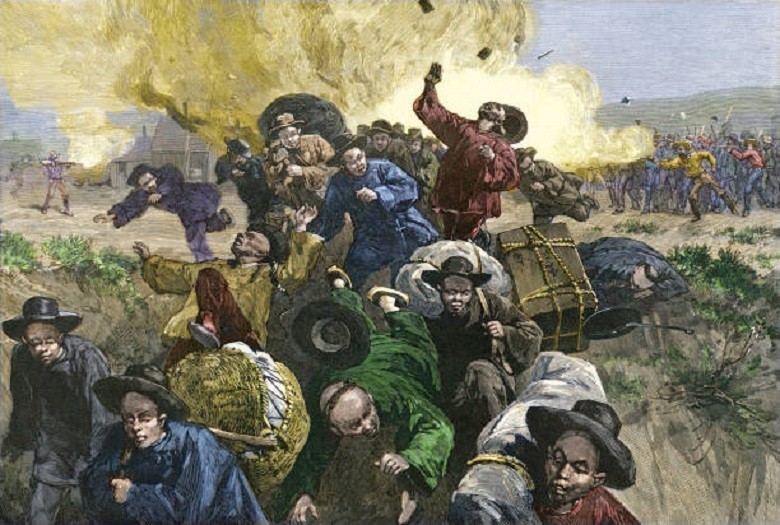
views
The Rock Springs Massacre: A Tragic Convergence of Racial Tensions and Labor Strife
On the afternoon of September 2, 1885, the small town of Rock Springs, Wyoming, became the site of one of the most horrifying acts of racial violence in the American West. Known as the Rock Springs Massacre, this tragic event saw a group of white miners attack and murder at least 28 Chinese miners, with some estimates suggesting the number could have been higher. Along with the brutal killings, the attackers set fire to homes, businesses, and the entire Chinese quarter of the town. The aftermath left the Chinese immigrant community devastated, their livelihoods destroyed, and their futures uncertain.

The Rock Springs Massacre was not just an isolated incident. It was a flashpoint that encapsulated the simmering racial tensions, labor disputes, and broader social unrest that were taking root in the United States during the late 19th century. The massacre would reverberate through the decades, leaving deep scars on both the Chinese immigrant community and the American labor movement. Yet, it would also serve as a catalyst for increased protections for immigrant workers, sparking debates about labor rights, racial inequality, and the need for justice.
In this exploration of the Rock Springs Massacre, we will delve into the roots of the violence, the cultural and economic climate that set the stage for this bloody confrontation, and the lasting legacy it left behind. Through a mix of historical context, personal stories, and sociopolitical analysis, we will seek to understand the motivations behind the massacre, the impact it had on both the Chinese and white communities, and how it changed the course of labor rights and racial relations in the United States.
A Divided Nation: Racial Tensions and the Chinese Immigrant Experience
In the decades following the Civil War, America was grappling with the consequences of industrialization, westward expansion, and the aftermath of the abolition of slavery. The rapid development of the American economy, especially in the growing mining, railroad, and agricultural industries, created a labor shortage that needed to be filled by workers of all backgrounds. Among those who answered the call were immigrants from China, many of whom sought a better life in the United States after hearing of the opportunities in the booming West.
Chinese immigrants arrived in the United States in large numbers beginning in the 1850s, driven by the promise of economic opportunity, particularly in the West. The Transcontinental Railroad and mining jobs offered a chance at prosperity, albeit in harsh and grueling working conditions. While they played an essential role in building the nation’s infrastructure, Chinese immigrants were often treated as second-class citizens. Faced with discriminatory policies, racial prejudice, and economic hardship, many Chinese workers took on some of the most dangerous and labor-intensive jobs, often for lower wages than their white counterparts.
However, the rise of the Chinese labor force was met with increasing resentment from white workers, who viewed them as competition for jobs. The economic pressures of the time, compounded by the arrival of more Chinese immigrants, fueled racial animosity. These tensions were further exacerbated by unions, which saw Chinese workers as a threat to their efforts to secure better wages and working conditions for white laborers. In this volatile environment, the stage was set for violent confrontations like the one in Rock Springs.
The Roots of the Rock Springs Massacre: Economic Strain and Labor Unrest
Rock Springs, Wyoming, was a bustling town at the time of the massacre, with a growing population driven by the expanding coal industry. The Union Pacific Railroad had established a major coal mine there, and by the 1880s, the town’s economy was largely dependent on the coal trade. The mine attracted a diverse labor force, including Chinese immigrants, who were brought in to perform the dangerous, low-paying work. The Chinese workers, who made up a significant portion of the mine’s workforce, were employed primarily as manual laborers in the most hazardous areas of the mine.
By the summer of 1885, relations between the Chinese miners and their white counterparts were growing increasingly strained. White miners, organized into labor unions, were upset with the fact that Chinese workers were often willing to work for lower wages, thus undercutting the wages of white miners. In an attempt to address this issue, white miners began to push for the expulsion of Chinese workers from the mines, believing that if the Chinese could be removed, it would create more opportunities for white miners.
Despite these tensions, the Chinese workers continued to toil in the mines, fearing for their livelihoods and hoping to eventually earn enough money to send back to their families in China. The Chinese laborers, who were often poorly treated, lived in segregated quarters, worked in the most dangerous conditions, and faced constant racial hostility. But they were undeterred, as they had few other options. Their lives and fortunes were now deeply tied to the mines.
Tensions finally reached a boiling point on the night of September 1, 1885, when a group of white miners gathered in the town and discussed a plan to evict the Chinese workers. The next day, they carried out their plans with violence and bloodshed.
The Massacre: September 2, 1885
On the morning of September 2, white miners launched their brutal attack on the Chinese workers. Armed with rifles and other weapons, they descended upon the Chinese quarter of Rock Springs, where the immigrant workers lived. The attackers stormed the area, shooting indiscriminately at the Chinese residents. Many Chinese miners, caught off guard by the assault, were killed outright, while others were wounded or forced to flee for their lives. Homes and businesses were looted and set on fire, further driving the Chinese community out of the area.
By the end of the day, at least 28 Chinese miners were dead, and many more were injured. The violence was so intense that some survivors were forced to escape into the nearby mountains, where they hid until it was safe to return. Entire families were displaced, with their homes and businesses destroyed in the chaos.
The massacre lasted for several hours, and the town of Rock Springs was left in shock. The attackers were emboldened by the apparent lack of any immediate response from local authorities. In fact, there were few attempts to bring the perpetrators to justice in the aftermath of the massacre, and the town’s residents were left divided. While some expressed outrage over the violence, many were sympathetic to the white miners’ grievances and saw the Chinese workers as an unwanted presence in the community.
The Aftermath: Legal and Social Consequences
The Rock Springs Massacre sent shockwaves throughout the nation, revealing the deep-seated racial animosities that existed in the United States at the time. The massacre drew widespread condemnation from both Chinese-American groups and some sections of the broader American public, but it also sparked debates about the treatment of Chinese immigrants and the need for labor reform.
In response to the incident, the federal government began to take action. The massacre highlighted the vulnerability of immigrant laborers in the United States and drew attention to the growing inequality in the nation’s labor markets. In the years following the massacre, there were increased efforts to protect immigrant workers from racial violence and discrimination, including stronger labor laws and new protections for Chinese workers.
However, the Chinese Exclusion Act of 1882, which had already severely restricted Chinese immigration to the United States, continued to loom large over the Chinese community. The law remained in place for decades, and Chinese immigrants were not granted citizenship or the same rights as other immigrant groups.
While the massacre was a pivotal moment in the history of racial violence and labor unrest in the United States, its legacy is a complex one. On the one hand, it galvanized efforts to secure better protections for immigrant workers, particularly in the West. On the other hand, it reinforced the deeply entrenched racial hierarchies that would continue to shape American society for years to come.
A Legacy of Violence and Reform
The Rock Springs Massacre stands as a tragic reminder of the racial and labor tensions that defined much of the American West during the late 19th century. It exposed the harsh realities of the Chinese immigrant experience and highlighted the volatility of labor relations in a rapidly industrializing economy. The violence was a direct response to the growing presence of Chinese laborers, who were seen as both a source of cheap labor and a threat to the economic status quo.
In the aftermath, though, the massacre helped spur important discussions about the treatment of immigrant workers and the need for labor reforms. It highlighted the need for protections against racial violence and discrimination, ultimately paving the way for labor and civil rights movements in the years to come. But even as it led to increased awareness, the legacy of racial inequality remained a persistent issue in American society.
Today, the Rock Springs Massacre serves as a somber chapter in the history of American labor and immigration, one that reminds us of the fragility of racial harmony and the complex struggles faced by immigrant communities throughout history.





















Comments
0 comment